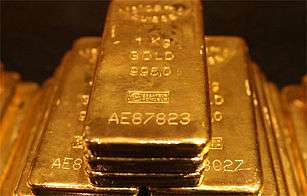Bullion
Bullion is gold bars, silver bars, and other bars or ingots of precious metal. The word bullion comes from the French Minister of Finance under Louis XIII, Claude de Bullion.
The value of bullion is typically determined by the value of its precious metals content, which is defined by its purity and mass. To assess the purity of gold bullion, the centuries old technique of fire assay is still employed, together with modern spectroscopic instrumentation, to accurately determine its quality in order and ensure the owner receives fair market value for it. It is also weighed extremely accurately.
Retailers may sometimes market ingots and bars of base metals, such as copper, nickel, and aluminium as bullion, but this is not a widely accepted definition.
As investment

The specifications of bullion are often regulated by market bodies or legislation. In the European Union, the minimum purity for gold bullion, which is treated as investment gold with regards to taxation, is 99.5% for gold bullion bars and 90% for bullion coins.[1]
There may be several reasons that investors choose to purchase physical gold bullion; to attempt to hedge against currency risks, inflation risks, geopolitical risks, or to add diversification to an investment portfolio.
London bullion market
The London bullion market is an over-the-counter market for wholesale trading of gold and silver. The London Bullion Market Association (LBMA) coordinates activities of its members and other participants in the London bullion market.
The LBMA sets and promotes quality standards for gold and silver bullion bars. The minimum acceptable fineness of the Good Delivery Bars is 99.5% for gold bars and 99.9% for silver bars.
Coins
Bullion coins describe contemporary precious metal coins minted by official agencies for investment purposes. Historically, most currency were in the form of bullion coins, silver and gold being the most common metals. Some bullion coins have been used as currency throughout the 20th century, like the Maria Theresa thaler and the Krugerrand. However, modern bullion coins generally do not enter common circulation despite having legal tender status and a nominal face value. Some modern bullion coins, such as the gold and silver American eagle, are produced as both business strike and collectible proof and uncirculated versions. Business strikes typically are sold at prices commensurate with their precious metal content, whereas collectible versions are sold at a significant premium over their actual bullion value. In some cases the grade and mintages of business strike coins can affect their value, so that they are considered numismatic rather than bullion items.
Uses
A range of professional market participants is active in the bullion markets: banks, fabricators, refiners and vault operators or transport companies as well as brokers. They provide facilities for the refining, melting, assaying, transporting, trading and vaulting of gold and silver bullion.[2]
Besides the direct bullion market participants, other professional parties like investment companies and jewelers use bullion in the context of products or services which they produce or offer to customers. For example, shares of the world’s largest Gold exchange-traded fund, the SPDR Gold Shares represent ownership in vaulted gold bullion.
Private individuals use bullion primarily as an investment or potential store of value. Gold bullion and silver bullion are the most important forms of physical precious metals investments. Bullion investments can be considered as insurance against inflation or economic turmoil and may not entail direct counterparty risk.
Compared to numismatic coins, bullion bars or bullion coins can typically be purchased and traded at lower margins and their trading prices are closer to the values of the contained precious metals.
Occasionally, consumers who are unaware of the intrinsic value of a coin will use it as normal currency. If a coin is taken to a bank, the bank can only pay the face value of the coin. However, if it has intrinsic value, it is worth much more.
See also
References
- ↑ Council Directive 98/80/EC of 12 October 1998 - Special scheme for investment gold: http://eur-lex.europa.eu/LexUriServ/LexUriServ.do?uri=CELEX:31998L0080:en:HTML
- ↑ A Guide to the London Precious Metals Markets: http://www.lbma.org.uk/assets/OTCguide20081117.pdf